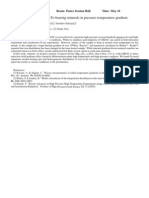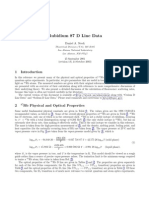Structural and Thermodynamic Analysis of Whiskers On The Surface of Grey Cast Iron
Structural and Thermodynamic Analysis of Whiskers On The Surface of Grey Cast Iron
Uploaded by
Aleš NagodeCopyright:
Available Formats
Structural and Thermodynamic Analysis of Whiskers On The Surface of Grey Cast Iron
Structural and Thermodynamic Analysis of Whiskers On The Surface of Grey Cast Iron
Uploaded by
Aleš NagodeOriginal Title
Copyright
Available Formats
Share this document
Did you find this document useful?
Is this content inappropriate?
Copyright:
Available Formats
Structural and Thermodynamic Analysis of Whiskers On The Surface of Grey Cast Iron
Structural and Thermodynamic Analysis of Whiskers On The Surface of Grey Cast Iron
Uploaded by
Aleš NagodeCopyright:
Available Formats
Fig.1 Fe-O phase diagram, and partial pressure of oxygen at 400 C, 600 C, 800 C and 1000 C.
For the calculation of particular phase diagram, Fig.1, the data for pure elements were taken from Dinsdale [1], for the substances data from Ansara [2]. Thermodynamic assessments on the Fe-O phase diagram were done by Sundman [3] and Selleby and Sundman [4]. The calculation of the phase diagram was done using Thermo-Calc software (TCW5). The calculations were performed using eq.1 and eq. 2. The activity of oxygen was taken to be 1 as in the case of pure metal. The equation for oxidation of pure metal is given with eq.1:
2u 2 Me( s ) + O2 = Meu Ov ( s ) v v eq.1
1 G = G 0 + RT ln po2 (eq.) = G 0 RT ln po2 (eq.)
eq.2
Where G and G 0 represents change in Gibbs free energy and standard free energy of formation. R is the gas constant (8.3144 Jmol -1K-1), T temperature (K) and po 2 (eq.) (atm) is equilibrium (dissociation) pressure of iron oxide. The calculations were done for equilibrium conditions, G = 0 . Constant isobars at specific temperatures revealed large variations of dissociation pressures of iron oxides existing between different oxide regions. So, proper heating and cooling conditions (with controlled partial pressure-oxygen content inside the gas reservoir) are needed for controlled growth of oxides. If the value po 2 for a given atmosphere under consideration lies under the dissociation pressure of iron oxide po 2 (eq.) , this oxide will dissociate into the oxygen and metal. On the contrary, if the value po2 lies above the dissociation pressure of iron oxide po 2 (eq.) , then the iron oxide is stable.
1 A.T. Dinsdale, SGTE Data for Pure elements, Calphad 15 (1991) 4 p.317-425 2 I. Ansara, SGTE substance database (2000) 3 B. Sundman, J.Phase Eq. 12 (1991), p. 127-140 4 M. Selleby and B Sundman, Calphad 20 (1996), p. 381-392
You might also like
- Determination of Lead-Tin Phase Diagram Using Cooling CurvesDocument5 pagesDetermination of Lead-Tin Phase Diagram Using Cooling CurvesSandra de la Merced100% (1)
- Andre Uss I 2017Document9 pagesAndre Uss I 2017Eder Ruiz HernandezNo ratings yet
- Calculation of Potential Energy Parameters FromDocument5 pagesCalculation of Potential Energy Parameters FromEnkh-Amar ShNo ratings yet
- Fundamentals of Iron and SteelmakingDocument145 pagesFundamentals of Iron and SteelmakingMichela CarmeliNo ratings yet
- Exp - 9 - Reduction of Ferrous Raw MaterialsDocument9 pagesExp - 9 - Reduction of Ferrous Raw MaterialsIbrahim MücahitNo ratings yet
- Synthesis, Characterisation and Antimicrobial Activity of Bivalent Metal (ZN, CD, HG, PB and Ag) Chelates of 1, 2-Naphthoquinone DioximeDocument9 pagesSynthesis, Characterisation and Antimicrobial Activity of Bivalent Metal (ZN, CD, HG, PB and Ag) Chelates of 1, 2-Naphthoquinone DioximeIOSR Journal of PharmacyNo ratings yet
- A Thermoanalytic Study of Metal AcetylacetonatesDocument12 pagesA Thermoanalytic Study of Metal AcetylacetonatessorinamotocNo ratings yet
- J. F. Montiel Hernández, M. I. Reyes Valderrama, I. Rivera Landero, C. H. Rios-Reyes, M. A. Veloz Rodríguez, F. Patiño Cardona, V. E. Reyes-CruzDocument6 pagesJ. F. Montiel Hernández, M. I. Reyes Valderrama, I. Rivera Landero, C. H. Rios-Reyes, M. A. Veloz Rodríguez, F. Patiño Cardona, V. E. Reyes-CruzCarlosNo ratings yet
- Removal of Hydrogen, Nitrogen and Sulphur From Tool Steel During Vacuum DegassingDocument7 pagesRemoval of Hydrogen, Nitrogen and Sulphur From Tool Steel During Vacuum DegassingRasul BzNo ratings yet
- Enrichment of AISI 316L Steel Surface Layer With Rare Earth Elements Using Ion BeamsDocument3 pagesEnrichment of AISI 316L Steel Surface Layer With Rare Earth Elements Using Ion BeamsSuresh JeevaNo ratings yet
- Morphological and Electronic Tuning Ò Ni2P Through Iron Doping Towards Highly Efficient Water Splitting SIDocument23 pagesMorphological and Electronic Tuning Ò Ni2P Through Iron Doping Towards Highly Efficient Water Splitting SICB Dong SuwonNo ratings yet
- General Chemistry: Majal Rani O. Espiritu, MS Bio, LPTDocument86 pagesGeneral Chemistry: Majal Rani O. Espiritu, MS Bio, LPTRoselyn CarmenNo ratings yet
- Oxidation Behavior of Modified SUS316 (PNC316) Stainless Steel Under Low Oxygen Partial PressureDocument8 pagesOxidation Behavior of Modified SUS316 (PNC316) Stainless Steel Under Low Oxygen Partial Pressurekandula.munikumarNo ratings yet
- NIST LeadfreeSolder v4Document77 pagesNIST LeadfreeSolder v4jaskaran singhNo ratings yet
- SL - PAP - M.Tanahashi N.Furut - 2001 - Phase Equilibria of The MnO-SiO2-CrOx System at 1873K Under Controlled OxygDocument7 pagesSL - PAP - M.Tanahashi N.Furut - 2001 - Phase Equilibria of The MnO-SiO2-CrOx System at 1873K Under Controlled OxygEduardo CandelaNo ratings yet
- ElectrolysisDocument24 pagesElectrolysisSMELLY CATNo ratings yet
- Thermodynamic Properties of Titanium Dioxide, Niobium Dioxide and Their Solid Solutions at High TemperatureDocument9 pagesThermodynamic Properties of Titanium Dioxide, Niobium Dioxide and Their Solid Solutions at High TemperatureNaufal AdityasNo ratings yet
- Electrical Conductivity of MNZN Ferrite Single Crystals With A Small Number of Fe IonsDocument6 pagesElectrical Conductivity of MNZN Ferrite Single Crystals With A Small Number of Fe IonsBhabani Sankar SwainNo ratings yet
- Thermodynamic Properties of Minerals (Short Article) - A. Navrotsky (1995) WWDocument11 pagesThermodynamic Properties of Minerals (Short Article) - A. Navrotsky (1995) WWmonicaingenieraNo ratings yet
- Tutorial Sheet-10 (201 6-17) (16B1NPH532 (Materials Science) )Document1 pageTutorial Sheet-10 (201 6-17) (16B1NPH532 (Materials Science) )Vipul SinghNo ratings yet
- TetratainiteDocument11 pagesTetratainitedpicc8No ratings yet
- Electrochemistry FinalDocument76 pagesElectrochemistry Finalsmudgegaming4989No ratings yet
- The Ellingham Diagram: How To Use It in Heat-Treat-Process Atmosphere TroubleshootingDocument14 pagesThe Ellingham Diagram: How To Use It in Heat-Treat-Process Atmosphere TroubleshootingaiueoNo ratings yet
- Advs1089 Sup 0001 s1Document13 pagesAdvs1089 Sup 0001 s1ramya mNo ratings yet
- Bai Bao DSC PDFDocument2 pagesBai Bao DSC PDFPhuongUblMyNo ratings yet
- Corrosion ProtectionDocument11 pagesCorrosion ProtectionSASINo ratings yet
- Steelmaking RemovedDocument120 pagesSteelmaking Removedmadam99sirNo ratings yet
- Jurnal Kinetika Kimia PDFDocument10 pagesJurnal Kinetika Kimia PDFjosuabutarbutar0% (1)
- 11.a New Mechanism of Sodium Zirconate FormationDocument11 pages11.a New Mechanism of Sodium Zirconate FormationAlexander DeckerNo ratings yet
- 2 Palme 2008 Platinum-Group ElementsDocument6 pages2 Palme 2008 Platinum-Group ElementsAnonymous YSnVjegNo ratings yet
- Chapter - 11 - Heat and ThermodynamicsDocument40 pagesChapter - 11 - Heat and ThermodynamicsMohammed Aftab AhmedNo ratings yet
- Akihito Tachiyama, Tadashi Kondo and Tatsuhiro Sakaiya - Chemical Differentiation in Fe-Bearing Minerals in Pressure-Temperature-GradientDocument1 pageAkihito Tachiyama, Tadashi Kondo and Tatsuhiro Sakaiya - Chemical Differentiation in Fe-Bearing Minerals in Pressure-Temperature-GradientDrebuioNo ratings yet
- Ix-C-1066-16 Banno PDFDocument11 pagesIx-C-1066-16 Banno PDFClaude BouillotNo ratings yet
- Extraction of Metals NotesDocument6 pagesExtraction of Metals NotesAyush JadiaNo ratings yet
- Thermal Contraction of A Rotating SphereDocument1 pageThermal Contraction of A Rotating SphereResidyNo ratings yet
- Es903214u Si 001Document18 pagesEs903214u Si 001Ahasa FarooqNo ratings yet
- MatSci PrelimsDocument17 pagesMatSci Prelimssantovincent425100% (1)
- MY2200 Primary Metal 2002Document52 pagesMY2200 Primary Metal 2002LTE002No ratings yet
- 1904.12478 Arxiv Tb2Ti2O7Document18 pages1904.12478 Arxiv Tb2Ti2O7Suchanda MondalNo ratings yet
- Supporting InformationDocument23 pagesSupporting InformationG WynnNo ratings yet
- Nitrosyl QuestionsDocument1 pageNitrosyl QuestionsEllie CarterNo ratings yet
- Gold BibleDocument6 pagesGold BibleJob MateusNo ratings yet
- Themodynamics 2Document1 pageThemodynamics 2chiranjitnath1310No ratings yet
- Roasting of Sulphide Ores - Predominace Area DiagramDocument53 pagesRoasting of Sulphide Ores - Predominace Area DiagramAbhishek KumarNo ratings yet
- Fe-Nb-Ni (Iron-Niobium-Nickel) : Binary SystemsDocument4 pagesFe-Nb-Ni (Iron-Niobium-Nickel) : Binary Systemsabdul basitNo ratings yet
- A. I. Kriklya, A. S. Bolgar, A. V. Blinder, and V. B. ChernogorenkoDocument3 pagesA. I. Kriklya, A. S. Bolgar, A. V. Blinder, and V. B. ChernogorenkoJoseph StricklandNo ratings yet
- Assignment 4 BetterDocument2 pagesAssignment 4 BetterAnshu Kumar GuptaNo ratings yet
- Pyrometallurgy Lecture 5 Free Energy Temperature DiagramsDocument14 pagesPyrometallurgy Lecture 5 Free Energy Temperature DiagramsNhut NguyenNo ratings yet
- ElectrodeDocument32 pagesElectrodeAaron Phillip50% (2)
- Австри 2010 БодлогоDocument13 pagesАвстри 2010 БодлогоGerel BayrmagnaiNo ratings yet
- Rubidium 87 D Line Data: Daniel A. SteckDocument29 pagesRubidium 87 D Line Data: Daniel A. Steck4564016No ratings yet
- Lavrenko2006 High Temperature Oxidation of SilverDocument5 pagesLavrenko2006 High Temperature Oxidation of SilvermateoNo ratings yet
- Atomic Weights IUPACDocument17 pagesAtomic Weights IUPACHHSpapayaNo ratings yet
- N2O4 As SolventDocument6 pagesN2O4 As SolventfranklynNo ratings yet
- The Synthesis and Structural Properties of (M (Dippe) (G - C H S) ) Complexes of PD and PT and Comparison With Their Ni AnalogDocument8 pagesThe Synthesis and Structural Properties of (M (Dippe) (G - C H S) ) Complexes of PD and PT and Comparison With Their Ni AnalogHưng LucaNo ratings yet
- Deep Earth: Physics and Chemistry of the Lower Mantle and CoreFrom EverandDeep Earth: Physics and Chemistry of the Lower Mantle and CoreHidenori TerasakiNo ratings yet
- Practice Makes Perfect in Chemistry: Oxidation-ReductionFrom EverandPractice Makes Perfect in Chemistry: Oxidation-ReductionRating: 5 out of 5 stars5/5 (1)
- Bearing MaterialsDocument32 pagesBearing MaterialsAleš NagodeNo ratings yet
- Solidification of High Speed SteelsDocument4 pagesSolidification of High Speed SteelsAleš NagodeNo ratings yet
- Development of 7-12 % CR SteelsDocument23 pagesDevelopment of 7-12 % CR SteelsAleš NagodeNo ratings yet
- Enhanced Oxidation of The 9%Cr Steel P91 in Water Vapour Containing EnvironmentsDocument27 pagesEnhanced Oxidation of The 9%Cr Steel P91 in Water Vapour Containing EnvironmentsAleš NagodeNo ratings yet
- Indentification of MartensiteDocument6 pagesIndentification of MartensiteAleš NagodeNo ratings yet
- Fe CR ReviewDocument25 pagesFe CR ReviewAleš NagodeNo ratings yet
- FractogtalkDocument15 pagesFractogtalkbronx_ldNo ratings yet
- Review of Creep Resistant SteelsDocument4 pagesReview of Creep Resistant SteelsAleš NagodeNo ratings yet
- Metallurgical Properties of Cast IronsDocument21 pagesMetallurgical Properties of Cast IronsAleš NagodeNo ratings yet
- Wiedemann Franz LawDocument3 pagesWiedemann Franz LawAleš NagodeNo ratings yet
- Precipitation in Creep Resistant Austenitic Stainless SteelsDocument14 pagesPrecipitation in Creep Resistant Austenitic Stainless SteelsAchiaa Osei-DonkorNo ratings yet
- CopperDocument21 pagesCopperAleš NagodeNo ratings yet
- Recent Advances in Creep Resistant Steels For Power Plant ApplicationsDocument22 pagesRecent Advances in Creep Resistant Steels For Power Plant ApplicationsTaylor W. HickemNo ratings yet
- Strengthening REVIEWDocument9 pagesStrengthening REVIEWAleš NagodeNo ratings yet
- EtchingDocument3 pagesEtchingAleš NagodeNo ratings yet










































































